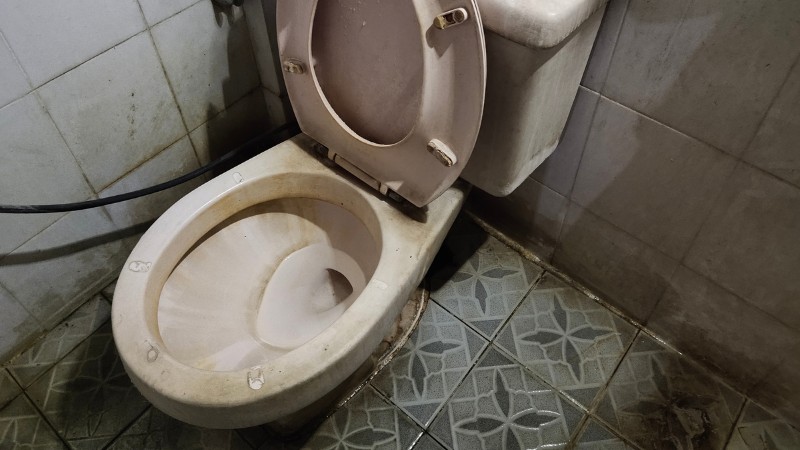No matter how often you scrub, your toilet still looks like it hasn’t been touched in weeks. Those stubborn brown rings and cloudy white streaks?
Yep, they’re not just grime—they’re hard water stains. You’re not alone in this battle either. Around 85% of U.S. households deal with hard water, so if it feels like you’re constantly cleaning the same marks, you’re in good company.
These stains are more than just an eyesore; they indicate significant mineral build up . They come from minerals like calcium and iron that hitch a ride through your water supply and settle in your toilet bowl. Over time, they stick around like unwanted guests, making your bathroom look less-than-fresh no matter how often you clean.
But here’s the good news: you don’t need harsh chemicals or a new toilet to fix it. In this guide, we’ll show you the best tips to remove hard water stains safely—and how to prevent hard water stains from coming back. Let’s get into it.
What Causes Hard Water Stains in Toilets?
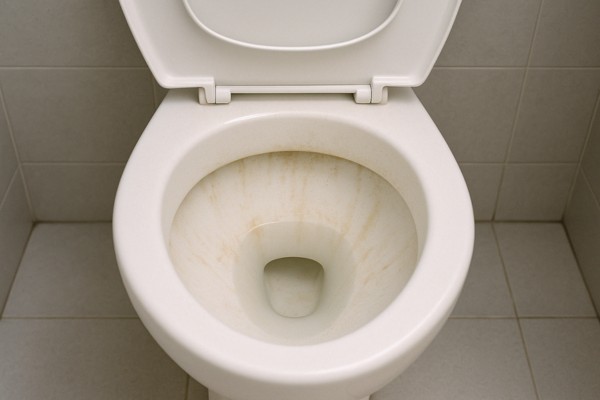
Hard water stains are the result of minerals that are naturally present in your water, mainly calcium and magnesium.
When you flush your toilet, the water leaves behind these minerals, especially in areas where it doesn’t drain completely, like the waterline or the base of the bowl. Over time, these minerals cling to the porcelain, especially at the water line forming those frustrating crusty deposits we know all too well.
You’ll often see these stains appear as either white rings or rust-colored marks.
Both are caused by mineral buildup, but the white stains usually stem from calcium, while the rusty ones are often from iron. These stains are typically more visible in areas where the water sits longer, making the toilet bowl’s waterline a prime spot for them to form.
As the minerals sit there, they begin to harden, becoming more stubborn to remove. What might’ve started as a small, easy-to-clean spot can gradually turn into a bigger headache. Without the right cleaning technique, these stains will only become more embedded and tougher to get rid of.
And, no matter how many times you clean, they just seem to keep coming back. That’s the reality of hard water stains—Once they’ve formed, they’re not going anywhere without a little elbow grease and the right tools, so consider wearing rubber gloves for protection!
Supplies You’ll Need
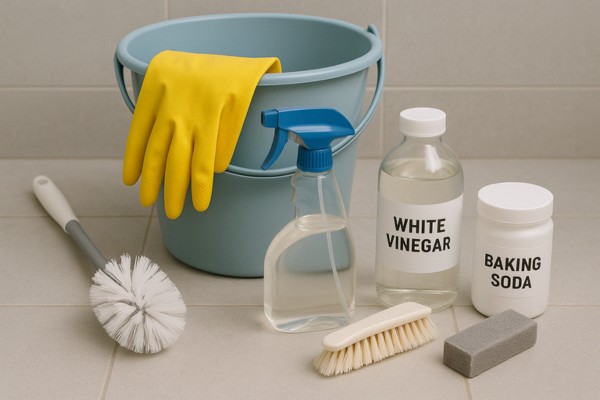
Before tackling those hard water stains, gather the following supplies. Luckily, most of them are common household items, so you won’t need to head to the store for anything fancy.
- Rubber gloves
- Toilet brush or pumice stone
- White vinegar
- Baking soda
- Borax (optional)
- Lemon juice (optional)
- Spray bottle
- Old toothbrush or scrub brush
- Bucket or cup (for flushing manually, if needed)
These supplies are all non-toxic and safe to use around the house. They’re not only effective for cleaning but also much gentler on your plumbing and septic systems compared to harsh commercial cleaners.
Plus, you’ll feel good knowing you’re keeping things natural!
6 Ways to Remove Hard Water Stains From Toilet
1. Flush and Empty the Bowl
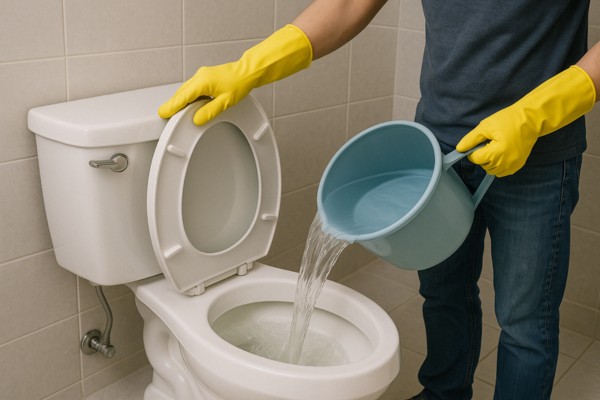
The first step to tackling those hard water stains is giving your toilet a quick flush to lower the water level.
You want to start with as little water in the bowl as possible so that your cleaning solutions can get to work directly on the stains. If you need to do a deeper clean, grab a bucket or cup to manually remove any remaining water.
This step is key because, without lowering the water level, your cleaning products won’t have the proper chance to sit and break down the mineral buildup.
Imagine you’re cleaning a window—if there’s too much water, your cleaning solution just slides off without ever touching the dirt.
The same goes for your toilet bowl. By creating a dry surface, you allow your vinegar, baking soda, and other solutions to really go to work on those hard water deposits.
Once the bowl is ready, you’re all set to move on to the next step—where the real magic happens!
2. Use White Vinegar and Baking Soda (Natural Power Duo)
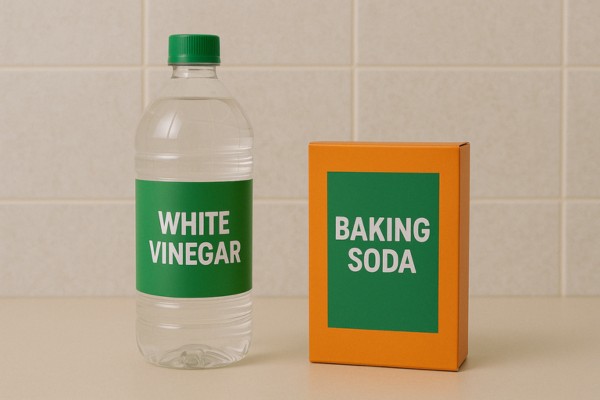
Now for the secret weapon in your cleaning arsenal—white vinegar and baking soda.
This dynamic duo is not only effective but also safe for your toilet and plumbing. If you’re dealing with mild to moderate stains, this simple yet powerful combo works wonders.
Start by pouring one cup of white vinegar directly into the toilet bowl, making sure to coat the stained areas.
Let it sit for about 10 minutes so the vinegar can break down the mineral buildup. You’ll start to notice the vinegar fizzing and loosening up the stains as it works its magic.
After your 10-minute wait, grab baking soda and sprinkle a cup of it into the bowl. Then, pour in another cup of vinegar.
You’ll see it fizz and bubble—this reaction helps lift the stains from the porcelain. It’s like watching a mini science experiment unfold in your bathroom!
Let this powerful solution sit for about 20 to 30 minutes.
In the meantime, you can sit back and relax, knowing the fizzing action is doing all the hard work. Once the time’s up, grab your toilet brush and scrub away the stains.
Give it one final flush to clear everything away, and voilà—your toilet bowl is sparkling again!
Best for: Mild to moderate stains and regular maintenance.
3. Try Borax for Stubborn Buildup
If your hard water stains have been sitting around for a while and have become stubborn, it might be time to pull out the heavy hitter: Borax.
This household powerhouse, combined with vinegar, can break down even the most stubborn mineral buildup.
Start by sprinkling about 1/4 cup of Borax into your toilet bowl.
Then, pour 1 cup of vinegar over it. The two will react, creating a fizz that loosens even the toughest stains.
Let this magic brew sit for about 30 minutes to 1 hour, allowing the Borax and vinegar to really work their way into those crusted-on stains.
Think of it like using a deep-cleaning facial scrub for your toilet bowl—this combo exfoliates away all that stubborn mineral buildup, leaving the surface much cleaner.
After the waiting period, grab your toilet brush and scrub thoroughly. Then, flush to rinse away all the grime. The result? A toilet bowl that looks like new again!
You can also create a paste by mixing Borax and vinegar if the stains are really set in. Apply it directly to the stained areas, let it sit, then scrub it off for extra cleaning power.
Best for: Older, crusted-on mineral stains.
4. Use a Pumice Stone for Spot Scrubbing
When the stains refuse to budge with liquids alone, it’s time to bring in the big guns—a pumice stone.
This natural rock can work wonders on hard water deposits, but there’s a trick to using it without damaging your toilet’s porcelain surface.
Start by wetting the pumice stone—it should always be damp to prevent scratching. Think of it like wetting a sponge before you use it, just to keep things smooth.
Once it’s damp, gently scrub over the stained areas, applying light pressure. Focus on the waterline and below-rim areas, where hard water stains tend to cling the most.
The key here is to be gentle. You don’t want to go in too hard and risk scratching your toilet. If you feel resistance, take a step back and try again with a little less pressure.
As you scrub, rinse the pumice stone frequently to wash off any loosened mineral buildup. This will keep the stone working efficiently and prevent it from spreading the grime around.
Caution: Only use a pumice stone on porcelain surfaces. Avoid using it on colored or coated toilet bowls, as it can damage the finish.
It’s like using a rough sandpaper—perfect for tough stains but not for delicate surfaces!
5. Lemon Juice and Salt Paste
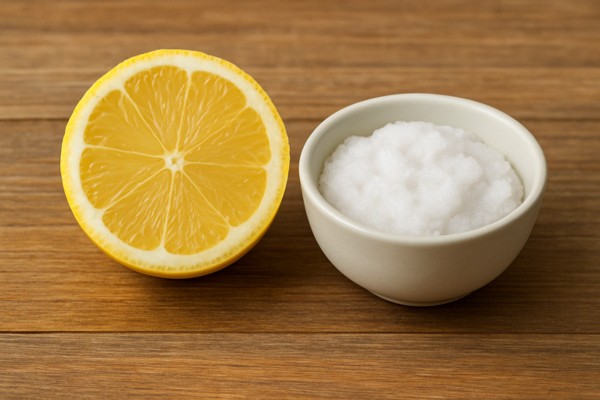
Looking for another natural solution to fight those stubborn stains?
Try using lemon juice and salt for a fresh-smelling, effective cleaning paste. This dynamic duo is perfect for targeting iron and rust stains, especially if you’re dealing with those frustrating orange-brown marks.
To create your paste, simply mix lemon juice with salt until it forms a thick consistency. Then, apply it directly to the stained areas, focusing on the spots with the most discoloration.
Let it sit for 20 minutes—this gives the natural acids in the lemon juice time to break down the iron buildup, while the salt gently scrubs away the stains.
While you’re waiting, take a moment to enjoy the fresh citrus scent that starts filling the air! After the 20 minutes are up, grab your toilet brush and give the stains a good scrub, then flush to reveal a cleaner, fresher toilet.
Bonus points: Not only does this method remove stains, but it also leaves your bathroom smelling like a citrus grove!
Best for: Iron/rust stains and a fresh, clean scent.
6. Prevent Future Stains
Now that your toilet is sparkling clean, let’s talk about keeping it that way. The best defense against hard water stains is a good offense—regular maintenance.
Start by cleaning your toilet weekly. Even a quick wipe-down helps prevent mineral buildup from settling in the first place. This will save you from dealing with tough stains down the road. It’s like maintaining your car—regular check-ups prevent bigger issues later.
If you live in an area with hard water, consider installing a water softening system. This can drastically reduce the amount of minerals in your water supply, making it much harder for them to form those stubborn stains.
Imagine having a shield that stops the buildup before it even starts.
For ongoing prevention, try a vinegar soak once a month. Just pour some white vinegar into the bowl and let it sit overnight. This will keep any minor buildup at bay, so you won’t have to deal with a serious stain situation later.
If you’re looking for even less hassle, consider using automatic toilet bowl cleaners that contain citric acid. These help break down minerals and keep your toilet fresh with minimal effort.
With these steps in place, you’ll keep those pesky stains from returning and maintain a clean toilet all year long!
Want a Stain-Free Bathroom Without the Hassle?
Let’s face it—hard water stains are stubborn, and scrubbing toilets isn’t exactly on anyone’s list of favorite chores. If you’d rather avoid the elbow grease and get back to enjoying your sparkling clean bathroom, let Modern Maids handle it for you.
Our professional team knows exactly how to get hard water stains out of toilet, along with tackling every corner of your bathroom. Whether it’s your toilet, sink, or tub, we’ll leave everything spotless, sanitized, and stain-free—so you can enjoy a bathroom that feels fresh every day.
Call us at (469)-430-8860
Book your bathroom deep cleaning here: modern-maids.com/booking-page
Let us do the dirty work, so you can relax and enjoy your sparkling clean home—without lifting a finger!
FAQs
How do you remove hard calcium deposits from a toilet?
To remove hard calcium deposits from your toilet, try using white vinegar. Pour about one cup of vinegar into the toilet bowl, focusing on the stained areas. Let it sit for 10 to 15 minutes, then scrub with a toilet brush or a pumice stone for tougher stains. If the stains persist, you can also add baking soda to the mix to boost the cleaning power. Regular cleaning with vinegar will help prevent calcium buildup from returning.
How do you remove encrusted limescale from a toilet?
Removing encrusted limescale from your toilet can be done using a mix of white vinegar and baking soda. Pour the vinegar into the bowl and let it sit for about 10 minutes. Afterward, sprinkle baking soda into the water and let the fizzing action break down the limescale. For stubborn deposits, a pumice stone works wonders. Gently scrub the affected areas, particularly around the waterline, and flush to rinse away the residue.
What dissolves hard water deposits in the toilet?
White vinegar is one of the most effective solutions to dissolve hard water deposits in your toilet. Simply pour about one cup of vinegar into the bowl and let it sit for 30 minutes to an hour. The acidity in the vinegar helps break down the mineral buildup caused by hard water. For additional power, combine it with baking soda or Borax. Regular vinegar soaks can keep your toilet free of hard water stains.
